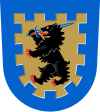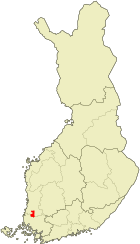Eura
| coat of arms | map |
|---|---|

|

|
| Basic data | |
| State : |
|
| Landscape : | Satakunta |
| Administrative community : | Rauma |
| Geographical location | 61 ° 8 ′ N , 22 ° 8 ′ E |
| Surface: | 630.26 km² |
| of which land area: | 578.90 km² |
| of which inland waterways: | 51.36 km² |
| Residents : | 11,748 (Dec. 31, 2018) |
| Population density : | 20.3 inhabitants / km² |
| Municipality number : | 050 |
| Language (s) : | Finnish |
| Website : | www.eura.fi |
Eura is a municipality with 11,748 inhabitants (as of December 31, 2018) in western Finland . It is located in the Satakunta landscape on the Eurajoki River a few kilometers north of its outflow from Lake Pyhäjärvi .
Districts
With a total of around 6,700 inhabitants, the meanwhile grown together places Eura and Kauttua form the community center. The parish also includes the parish villages of Hinnerjoki and Honkilahti and the towns of Auvainen, Haveri, Isovahe, Komoinen, Korpi, Lähteenoja, Lellainen, Löyttylä, Mannila, Mestilä, Mikkola, Naarjoki, Sorkkinen, Soupas, Turajärvi and Vaaljokhei.
history
Eura and the neighboring municipality of Lappi are known for numerous archaeological finds that testify to the rich early history of the region. Finds from the Stone, Bronze and Iron Ages are shown in the Museum Naurava Lohikäärme ("Laughing Dragon"), in Mannila there is an open-air museum with a reconstructed Iron Age village.
Eura has existed as an independent parish since 1657. After 1689, when Baron Lorenz Creuz set up a forge in Kauttu, the place developed into a center of the Finnish metal industry and remained so until the early 20th century. After the Ahlström Oy group set up a paper mill in 1907, the wood and paper processing industry became the most important branch of the economy. In 1970 the parishes of Hinnerjoki and Honkilahti were incorporated. At the beginning of 2009, Kiukainen was incorporated.
Cultural monuments
The single-nave brick church of Eura was built in 1898 according to plans by Josef Stenbäck , the wooden churches by Hinnerjoki and Honkilahti in 1755 and 1759 respectively. Some buildings by Alvar Aalto in the community center are still of architectural interest .
Town twinning
Personalities
- Carl Reinhold Sahlberg (1779–1860), natural scientist
- Darude (* 1975), DJ
Web links
Individual evidence
- ↑ Maanmittauslaitos (Finnish land surveying office): Suomen pinta-alat kunnittain January 1, 2010 (PDF; 199 kB)
- ↑ Statistical Office Finland: Table 11ra - Key figures on population by region, 1990-2018


